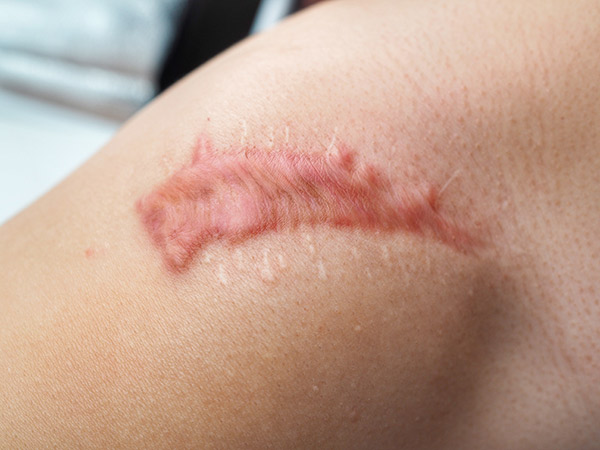Hypertrophic And Keloid Scarring
Hypertrophic scars are thick raised scars that are due to overproduction of collagen within a wound. This type of scarring is related to an over response to the original trauma or injury. They tend to be more common in scars that become infected or inflamed. They can also come from wounds that are under a lot of tension or were not closed with sutures when needed. They do not grow beyond the boundaries of the original injury. Hypertrophic scars can occur on any part of the body. Hypertrophic scars develop in all skin types.
Keloid scars are similar but are not the same thing as a hypertrophic scar. Keloid scars are also an abnormal response to injury but they can grow outside the boundaries of the original injury. They may continue to grow over time. Keloids tend to form on the earlobes, shoulders, cheeks and chest. Keloid scarring tends to be more common in patients with darker skin.
Hypertrophic and keloid scarring

Prevention:
- Pressure Dressings – this will make it more difficult for the scar to become elevated.
- Silicone gel pads – these have shown promise to decrease the size of the keloid and are best when started at the first sign of keloid scar formation. You will need to treat daily for up to 3 months.
- Sutures – if a wound needs sutures it is best to get the wound closed by a physician. Correct closure will decrease the risk of a hypertrophic scar forming.
Treatment:
- Steroid Injections – this can benefit both keloid and hypertrophic scars. It will require injections once a month until the desired improvement occurs.
- Cryosurgery – This may be beneficial along with the injection of steroids to decrease the bulk of the scars.
- Fractional Lasers – Fractional lasers like the DeepFX or ProFractional Laser can be beneficial to decrease the height and firmness of hypertrophic scars. Fractional lasers may also be beneficial for keloid scarring when a strong steroid such as Clobetasol is applied following the laser or microneedling treatment. This will decrease the firmness as well as the height of the scars.
- Microneedling – The Collagen PIN is similar to using the fractional lasers and can be less costly for both hypertrophic and keloid scars.
- Ablative lasers – This should only be used on smaller scars to level them out with the skin. I prefer to use the erbium laser as it is less traumatic to the skin. The CO2 lasers induce more trauma and may lead to more scarring.
- Surgical Excision – this is possible for the removal of hypertrophic scarring or smaller keloids. Keloids have a high incidence of reoccurring after surgical excision. It is very important to wait at least 1 year following the development of a keloid and to watch the surgical site for keloid formation following surgical excision. It is bet to start injecting a steroid into the injury as soon as keloid formation begins.

